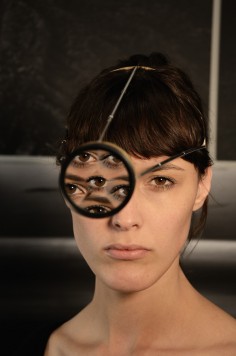Joachim Rotteveel
Vision Machines

source: joachimrotteveel
Vision Machines is all about tools that force people to look at art. In my current research on using robots to look at art, I question how people look at art. Is it possible to force someone to really see a work of art? Must a viewer be open to a subject to be critical and enjoy a painting? Such questions arise from the current debate on whether a work of art can only be meaningful for people who want to delve into it. The artworks I made for the MX7 Gallery influence the space located between the observer and the art object. The process of looking at art, and perception itself, are questioned through a series of objects and photo documentation. They reveal the viewer’s own way of seeing and provide an alternative gateway to the viewing process.
The wearable assemblies consist of recycled objects – including the world of photography – constructed with wire frames of brass and silver solder. The 3d works hang in the gallery at eye level as if they are worn by unseen visitors. Also exhibited are pictures of models that demonstrate the work. On the right a video-loop of the piece Shutter realised with Geert Sinke. I shot the fotos below on location in Antwerp at FoMu with the work of photographer Elke Andreas Boon and media artist Frederik De Wilde in the MX7 Gallery. Models: Annelie Ansingh, Lotte Hoogzand, Margot Hierholz, Geert Sinke.
.
.
.
.
.
.
.
source: v2nl
Joachim Rotteveel is an artist based in The Hague, Netherlands, who utilizes techno-scientific methods to represent ideas about contemporary culture. He studied Autonomous Art at St.Joost in ’s-Hertogenbosch and completed his Master of Science in Media Technology at Leiden University in 2005. At the art academy, he practiced traditional techniques like painting and sculpting.
In the following period he co-founded the media-collective “EyeGasm” with media-artists in Amsterdam. In this time he worked as a VJ using Amiga 1200’s, VHS-recorders and television screens. Since then his work has become more conceptual, focusing on technology and philosophy as a theoretical base for his work. His graduation-project for the MSc in MediaTechnology was an experimental research in controlling human motory-functions with a computer.
In 2008, his projects resulted in an exhibition with Museum Boijmans Van Beuningen where archaeological pottery was shown in the context of contemporary industrial rapid prototyping techniques.

